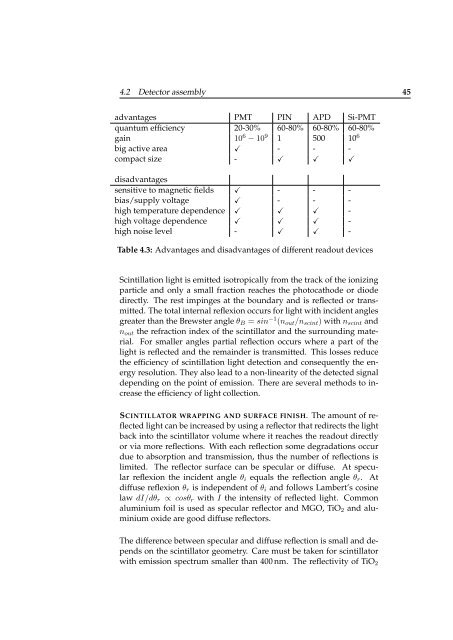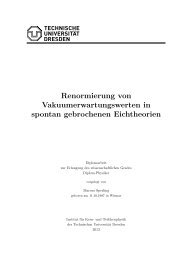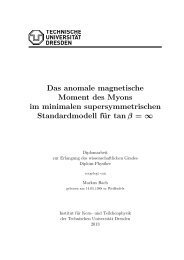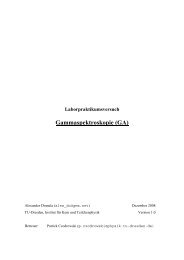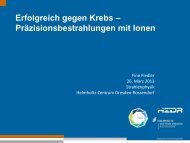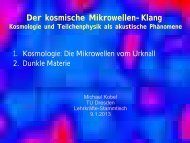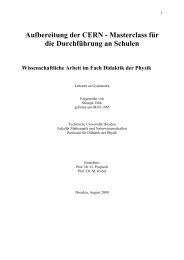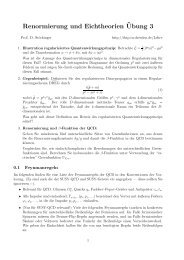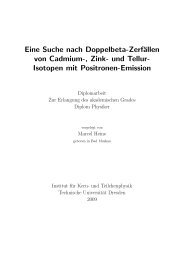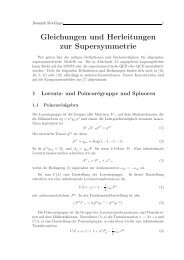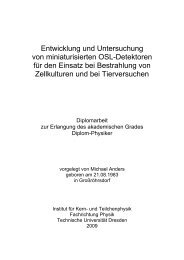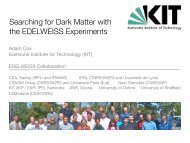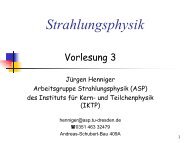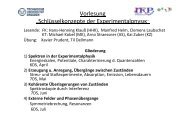a design study for a cobra upgrade to - Institut für Kern- und ...
a design study for a cobra upgrade to - Institut für Kern- und ...
a design study for a cobra upgrade to - Institut für Kern- und ...
Create successful ePaper yourself
Turn your PDF publications into a flip-book with our unique Google optimized e-Paper software.
4.2 Detec<strong>to</strong>r assembly 45<br />
advantages PMT PIN APD Si-PMT<br />
quantum efficiency 20-30% 60-80% 60-80% 60-80%<br />
gain 10 6 − 10 9 1 500 10 6<br />
big active area � - - -<br />
compact size - � � �<br />
disadvantages<br />
sensitive <strong>to</strong> magnetic fields � - - -<br />
bias/supply voltage � - - -<br />
high temperature dependence � � � -<br />
high voltage dependence � � � -<br />
high noise level - � � -<br />
Table 4.3: Advantages and disadvantages of different readout devices<br />
Scintillation light is emitted isotropically from the track of the ionizing<br />
particle and only a small fraction reaches the pho<strong>to</strong>cathode or diode<br />
directly. The rest impinges at the bo<strong>und</strong>ary and is reflected or transmitted.<br />
The <strong>to</strong>tal internal reflexion occurs <strong>for</strong> light with incident angles<br />
greater than the Brewster angle θB = sin −1 (nout/nscint) with nscint and<br />
nout the refraction index of the scintilla<strong>to</strong>r and the surro<strong>und</strong>ing material.<br />
For smaller angles partial reflection occurs where a part of the<br />
light is reflected and the remainder is transmitted. This losses reduce<br />
the efficiency of scintillation light detection and consequently the energy<br />
resolution. They also lead <strong>to</strong> a non-linearity of the detected signal<br />
depending on the point of emission. There are several methods <strong>to</strong> increase<br />
the efficiency of light collection.<br />
SCINTILLATOR WRAPPING AND SURFACE FINISH. The amount of reflected<br />
light can be increased by using a reflec<strong>to</strong>r that redirects the light<br />
back in<strong>to</strong> the scintilla<strong>to</strong>r volume where it reaches the readout directly<br />
or via more reflections. With each reflection some degradations occur<br />
due <strong>to</strong> absorption and transmission, thus the number of reflections is<br />
limited. The reflec<strong>to</strong>r surface can be specular or diffuse. At specular<br />
reflexion the incident angle θi equals the reflection angle θr. At<br />
diffuse reflexion θr is independent of θi and follows Lambert’s cosine<br />
law dI/dθr ∝ cosθr with I the intensity of reflected light. Common<br />
aluminium foil is used as specular reflec<strong>to</strong>r and MGO, TiO2 and aluminium<br />
oxide are good diffuse reflec<strong>to</strong>rs.<br />
The difference between specular and diffuse reflection is small and depends<br />
on the scintilla<strong>to</strong>r geometry. Care must be taken <strong>for</strong> scintilla<strong>to</strong>r<br />
with emission spectrum smaller than 400 nm. The reflectivity of TiO2


